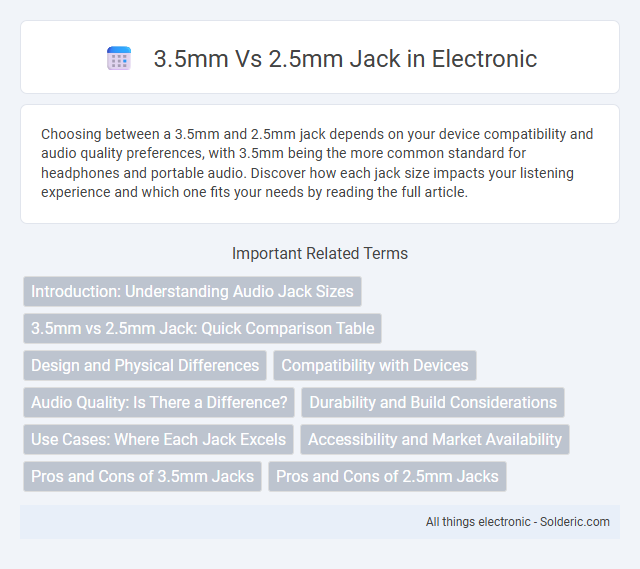Choosing between a 3.5mm and 2.5mm jack depends on your device compatibility and audio quality preferences, with 3.5mm being the more common standard for headphones and portable audio. Discover how each jack size impacts your listening experience and which one fits your needs by reading the full article.
Comparison Table
| Feature | 3.5mm Jack | 2.5mm Jack |
|---|---|---|
| Diameter | 3.5 millimeters | 2.5 millimeters |
| Common Use | Headphones, earphones, audio devices | Headsets, microphones, two-way radios |
| Audio Quality | Standard stereo sound | Lower stereo or mono, often for communication |
| Compatibility | Most smartphones, laptops, audio players | Some phones, older audio devices, communication gear |
| Durability | Generally robust, widely available | Less common, potentially fragile |
| Connector Types | TRS (Tip-Ring-Sleeve), TRRS (Tip-Ring-Ring-Sleeve) | Mostly TRS or TRRS for mono or stereo |
| Usage Trend | Industry standard for consumer audio | Declining use, niche applications |
Introduction: Understanding Audio Jack Sizes
Audio jack sizes like 3.5mm and 2.5mm differ primarily in diameter, with 3.5mm being the standard for most headphones and portable devices, offering compatibility and robust audio quality. The smaller 2.5mm jack is often found in older or specialized equipment, providing a more compact connection but limited compatibility with modern devices. Knowing these differences helps you choose the right cable or adapter, ensuring optimal audio performance and device compatibility.
3.5mm vs 2.5mm Jack: Quick Comparison Table
The 3.5mm jack is the industry standard for most headphones and portable audio devices, offering wide compatibility and stereo sound. The 2.5mm jack, smaller and less common, is often found in older mobile phones and some communication devices, providing a more compact connection but limited accessory support. Quick comparison highlights the 3.5mm jack's prevalence and versatility versus the 2.5mm jack's niche usage and size advantage.
Design and Physical Differences
The 3.5mm jack features a larger diameter, commonly used in smartphones, headphones, and audio equipment, while the 2.5mm jack is smaller and less prevalent, often found in older mobile devices and certain two-way radios. The 3.5mm jack typically supports stereo audio signals and microphones, whereas the 2.5mm jack is mainly used for mono audio or specialized communication peripherals. Physically, the 3.5mm connector provides more robust durability and better compatibility with a wide range of devices due to its size and standardized design.
Compatibility with Devices
The 3.5mm jack remains the most widely used audio connector, compatible with smartphones, laptops, headphones, and many other consumer electronics, ensuring broad device compatibility. In contrast, the 2.5mm jack is less common and often found on older or specialized equipment such as certain two-way radios and cordless phones, limiting its use with modern devices. You should verify your device's port size before purchasing accessories to guarantee proper fit and optimal audio performance.
Audio Quality: Is There a Difference?
The difference in audio quality between 3.5mm and 2.5mm jacks is typically negligible, as both support similar analog stereo signals. However, 3.5mm jacks are more commonly used and compatible with a wider range of devices, which can influence your overall audio experience. Your choice should focus more on device compatibility and build quality rather than expecting a significant audio performance variation between the two sizes.
Durability and Build Considerations
The 3.5mm jack is generally more durable due to its thicker gauge and more widespread use, making replacement parts and accessories more readily available. In contrast, the 2.5mm jack, being smaller and less common, tends to be more fragile and prone to bending or damage from frequent use. Build considerations favor the 3.5mm jack for devices requiring robust audio connections, while 2.5mm jacks are typically reserved for compact electronics where space savings outweigh durability concerns.
Use Cases: Where Each Jack Excels
3.5mm jacks excel in general consumer electronics such as smartphones, laptops, and headphones, due to their compatibility and widespread adoption. 2.5mm jacks are often preferred in specialized applications like two-way radios, aviation headsets, and certain professional audio equipment where compact size and secure connections are crucial. The choice between 3.5mm and 2.5mm jacks depends on device requirements, audio quality, and use case environments.
Accessibility and Market Availability
3.5mm audio jacks dominate the market, offering widespread accessibility across smartphones, headphones, and portable devices, making them a universal standard for audio connectivity. In contrast, 2.5mm jacks are less common and primarily found in niche or older devices, limiting their availability and compatibility with most consumer electronics. Your choice of audio jack impacts how easily you can find accessories and replacement parts, with 3.5mm providing far greater market support and convenience.
Pros and Cons of 3.5mm Jacks
The 3.5mm jack is widely used due to its compatibility with most consumer audio devices, offering convenience and broad accessibility. It supports stereo audio with adequate sound quality, though it tends to be less durable and more prone to connection issues compared to smaller jacks like the 2.5mm. Its larger size limits portability and integration into increasingly compact devices, which is a notable drawback compared to the more compact 2.5mm jack.
Pros and Cons of 2.5mm Jacks
The 2.5mm jack offers a smaller form factor, making it ideal for compact devices like certain handheld audio players and communication equipment. However, it is less common than the 3.5mm jack, limiting compatibility with most headphones and audio accessories. You might face challenges finding adapters or replacements, but its lightweight design contributes to more portable and streamlined audio setups.
3.5mm vs 2.5mm Jack Infographic

 solderic.com
solderic.com